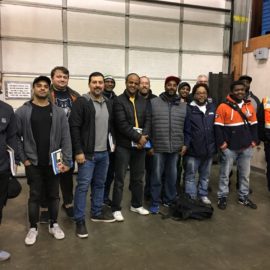
EMILY EVENSON AIA, RA, CPHD
Associate, Weber Thompson
Member, HDC’s Exemplary Buildings Program Task Force
Chair, HDC’s Policy Advisory Group
In the wake of social equity disparities coming to a head across the US, my architecture firm, Weber Thompson, is participating in an Equity, Diversity and Inclusion workshop using materials created by the American Institute of Architects called Guides for Equitable Practice. In reading the materials to prepare for a session, I found myself pondering this question with a few colleagues: What is an example of something “we have always done” that is, or may be, harmful to an inclusive and diverse work culture?”
If we zoom out and take stock of how we approach existing systems, we often find underlying assumptions that are not rooted in our current circumstances and need to be challenged or reconsidered. In terms of affordable housing, the following questions need to be considered to allow for a more equitable future for those affected by homelessness, housing insecurity, and/or lack of access to housing that’s safe, healthy, durable and affordable:
Why is the quantity of people housed so often valued above all else? Is there space in budgets to also value the quality, health, and environmental impact of these developments?
These questions are complicated and there is not a simple answer, but they should be continually asked and the forces that keep “quantity” at the top of the list should be challenged to consider the lasting impact it has on individuals and communities. Examples of how sustainable design principles benefit the health of the tenant and buyer are:
- lower levels of noise pollution for a quiet and more restful home;
- increased thermal comfort;
- low utility bills;
- high air quality; and
- improved durability and longevity.
Each of these can contribute to an overall healthier life. A more typical market-rate developer has incentive to build to these higher standards because target tenants are interested in the benefits, and budgets—including rent flow—often allow for these types of upgrades. As you can see, equity disparity expands the longer we build affordable homes without these sustainable concepts considered, allowing only the more affluent to benefit from these investments.
In this critical time where a climate crisis is nipping at our heels, we must also consider the long-term impact that the built environment has locally, regionally, and globally. If we continue building housing in the traditional way, we will be contributing to the problem of inequity as poorer communities across the globe are disproportionately affected by climate change.
By not addressing the problem now, we continue to put our local un- and under-housed communities at a disadvantage and vulnerable communities around the globe at greater risk for displacement and for experiencing housing crises. Beyond the typical “save the planet” rhetoric as a mechanism to drive sustainable decisions (which to me is a very meaningful argument in and of itself), we must also think of the impact climate change has, and will continue to have, on human life.
This is why I’m so excited to see the progress made by the Exemplary Buildings Program (EBP). EBP is developing a series of recommended guidelines to tackle one of the underlying issues around the inclusion of sustainable systems in the affordable housing continuum: the cost to research, design, and detail healthy and energy-efficient and durable building systems. (EBP’s guidelines are continually refined by data coming in from several affordable housing developments serving as demonstration projects).
Oftentimes, these systems are approached in a “reinvent the wheel” mindset that can be costly for the developer and add to the project schedule. As budgets are often set at a minimum, the goal is to lower the cost of investing in energy-efficient and sustainable building systems by cutting down the options to few succinct recommendations, shorten the timeline for implementation, and work towards an industry-wide comfort level with these higher-performing systems. As this process is implemented on more projects, the faster and more cost effective it will become, making it accessible to a broader range of affordable housing developments.
The EBP demonstration projects are one step towards a more equitable future for our un- and under-housed communities, and if implemented at scale, can have a lasting impact on the way we think about affordable housing, the health of the region, and our global impact.


